‘It is,” says the man standing next to me, leaning on the railings and watching a woman spin and twist on a pole, “a bit like being in Spearmint Rhino.” Admittedly, I’ve never been to the chain of strip clubs, but I’m pretty sure this is nothing like it. This is the World Pole Sports Championships, and we’re in a sweltering sports hall in the middle of the day, and the audience sitting on the spectators’ benches are mostly wearing tracksuits. And I’ve just spent the morning watching children perform pole routines.
Watching 12-year-olds climb a pole, wearing small, sparkly costumes and performing spins and holds – often with their legs wide open – is uncomfortable, despite the growing professionalism of this sport. It is true that it is not dissimilar to gymnastics – with routines performed to music, glittery costumes and makeup, and legs-spread moves – but gymnastics doesn’t have the baggage. Can pole sports ever leave this behind?
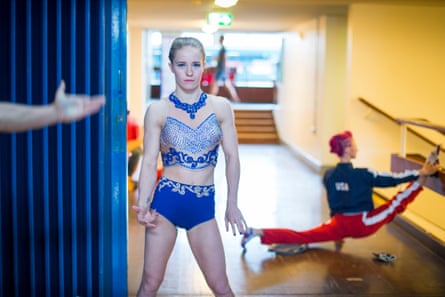
“There has been an incredible change,” says KT Coates, president of the International Pole Sports Federation, which is holding the championships in Crystal Palace, south London. “People’s attitudes have changed so much – they are much more open and I haven’t really had any negativity.” In the 90s, Coates was a dancer at the Raymond Revue bar, and later at clubs in Japan, and taught herself pole dancing because it could earn her more money. “I realised I was quite good at it. I ended up trying to sort my life out, came home and went to drama school. Part of being a resting actor is you had to have something else to do, so I set up a pole for a fitness class.”
It was difficult in the beginning, she says. “I couldn’t get any fitness studios [to take the classes on]. People were slamming down the phone on me and telling me I was disgusting.” But pole dancing classes started to take off. For a while, you couldn’t go to a hen party without being expected to gyrate around a pole in a class, and many feminists were riled by an offshoot from the sex industry making it into the mainstream. Coates wants to see pole sport included in the Olympics, although she admits that is probably a long way off. It isn’t yet recognised by SportAccord, the umbrella body for sports federations, but Coates says that is “only around the corner”.
It is incredibly demanding, she says. “You’re using muscles of your entire body. You get very strong. You can tell it’s becoming a sport by the physiques of the athletes. When we started, it used to be quite slim girls. Now most of the athletes are incredibly muscular. You have to have every element to win – flexibility, strength, choreography. It is tough.” Last year there were five male competitors, and this year there are 25. As we talk, two men from the Chilean team take to the stage for the doubles event – the first time two men have competed together. They swing and spin, muscles tightening.
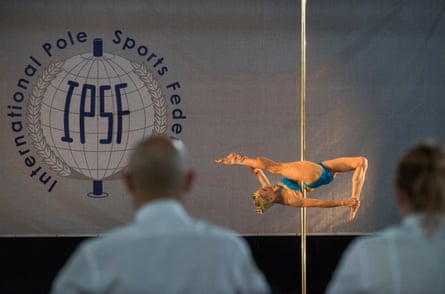
There are rules aimed at moving pole sport away from its strip-club shadows – costumes can’t be too skimpy, and there are no sexualised moves (no gyrating, hair flicking or grinding). “If someone got on stage and did that, the whole crowd would be in shock,” says Coates. “We’re not embarrassed of our history, it’s just that [pole sport] is a polar opposite.”
Are there competitors here who work in strip clubs? “No. I don’t know a single one. These are athletes. You are not going to get someone who does exotic dance doing the world sports championships – it just does not overlap. We have the same apparatus, but it’s not the same thing.”
But there is an overlap. I wander around the sponsors’ merchandise stalls, where you can buy tops with “pole dancer” or “sexy” written across the front. Doesn’t that undermine the efforts Coates is putting in to get away from the strip-club history? “The fact is that nobody [else] will sponsor us because of the stigma attached. Everybody is too scared to take that step.”
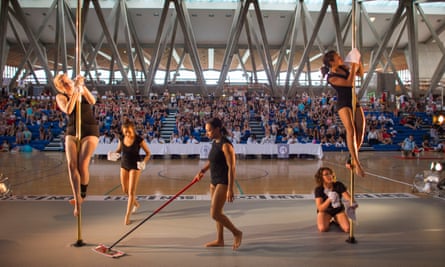
Elise Lander is used to hearing comments that she is a pole dancer, but she says she hears fewer of them these days. “If that’s what people want to think, that’s their decision. If they don’t want to understand what I do, it’s their problem.” Lander and her sporting partner, Vendi Andersson, are competing in the doubles category for Norway. She started pole sport in 2010; Andersson three years ago. “Originally, I wanted to dance, and I found a pole course. I went, and I was sold. I like that it challenges every aspect of my body – strength, flexibility and endurance, and the creativity of making a routine,” says Lander, who is a student and also works as a pole instructor. “I used to do climbing,” says Andersson, who is a nuclear scientist, “and I started doing pole because it’s the same upper-body strength, but I had to work on the dance part. It builds a lot of strength and you can make it very challenging.”
It was the difficulty that encouraged Serokurov Hennadiy, who is from Ukraine and competing in the men’s event, to take up pole five years ago. “I was a dancer and I liked this sport. I like the combination of power with dance.” He knows of only about 10 other men in Ukraine who do pole sport. “Many people think it is just for women. Or they think pole sport is strip dancing. I say all the time it’s not a dance from nightclubs. It’s difficult and, if you don’t believe it, you can try it.”
In the novices category, for children aged between 10 and 14, I watch 11-year old Paige Olson. She is graceful and strong, climbing the pole effortlessly and performing dizzying upside-down spins. At one point she holds her body, straight and rigid, away from the pole with both hands, and the audience claps. She is amazing to watch. Afterwards, I find her and her parents and, up close, swamped in a tracksuit, Olson is tiny. Over the course of the weekend, she will go on to win her category and become the world-record holder but, right now, she is hot and tired.
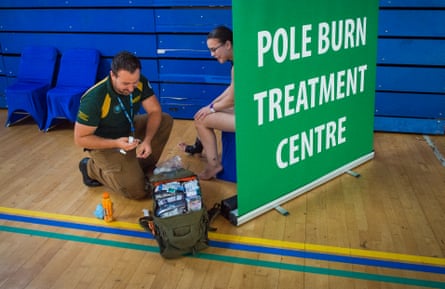
Olson started pole when she was nine, after a teacher at her dance class suggested it. Her ambition, she says, is to make it to the Olympics, and she is serious – she is home-schooled so that she can train six days a week and go to competitions. How did her parents feel about her taking on pole sport? “At first I wasn’t keen because of the stigma attached to it,” says Ivan, her father. “But then I saw how gymnastics-like it is, [unlike] the erotic side [that people imagine], and I became an instant advocate. I want to try to change the image of it, and I think it is changing.” He has to constantly explain to friends, colleagues and family what his daughter is doing. “People refer to it as ‘pole dancing’ and we have to correct them.” As he says this, over his shoulder I can see an advert from one of the clothing stands that has a picture of a woman, arched back and bottom sticking out, wearing a pair of plasticky high heels.
Do Olson’s parents have to be wary about how their daughter is portrayed? “We try to always have a costume that covers her belly, and we don’t put her in teeny shorts,” says her mother, Jennifer. “Everything is age-appropriate – not too much makeup. I talked to her about it, and she is aware of the other side of pole. If she hears any negative comments, I just say those people don’t understand. Usually when people see it, it changes their opinion.” I point out the advert behind her, where the imagery is all strip club, not Olympic sport. She makes a small grimace. “I don’t like the heels.”
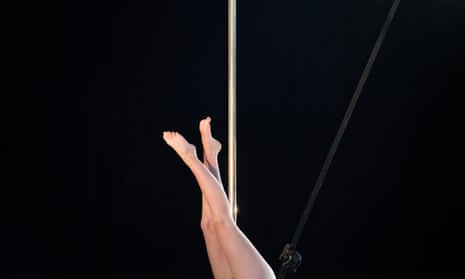
Comments (…)
Sign in or create your Guardian account to join the discussion